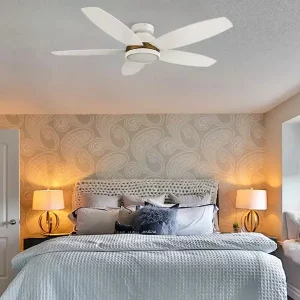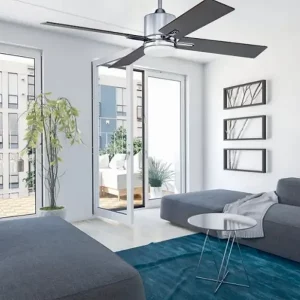Ceiling fans are an essential home fixture, combining practical air circulation and aesthetic appeal. With an array of sizes, blade configurations, and finishes available, choosing the right ceiling fan involves understanding proportions, cooling efficiency, and design nuances. This guide aims to simplify the selection process by addressing key factors such as ceiling height, room size, and more.
Determining the Right Size Ceiling Fan
The size of the ceiling fan should be proportional to the room. To choose correctly, start by measuring the square footage of the room. A mismatched fan size won’t circulate air effectively, compromising efficiency and comfort.
Ceiling fans are typically measured by blade span—the diameter of the circle the blades create when in motion. This measurement helps determine the appropriate fan size for a given space:
- Up to 50 sq. ft.: Fans 29 inches or smaller are suitable for hallways, laundry rooms, and walk-in closets.
- Up to 75 sq. ft.: A 36-inch fan fits well in breakfast nooks and large bathrooms.
- Up to 100 sq. ft.: Opt for a 42-inch fan for bedrooms, offices, or kitchens.
- Up to 225 sq. ft.: A 52-inch fan is ideal for master bedrooms, dining rooms, or covered patios.
- Up to 400 sq. ft.: A 56-inch fan or possibly two smaller fans will provide adequate airflow for large living areas or great rooms.
To ensure proper air flow, it’s recommended that the fan blades be kept 18 to 24 inches away from any wall or obstruction.
Ceiling Height and Fan Installation
The height at which a ceiling fan hangs is crucial for optimal performance:
- Low Ceilings: In rooms with 8 feet or lower ceilings, flush-mount fans are best as they provide clearance while maintaining a low profile.
- Average to High Ceilings: Fans intended for rooms with ceilings over 9 feet should use downrods to position the fan blades at an ideal height, usually 8 to 9 feet above the floor, to enhance air circulation.
Special Considerations
- Sloped Ceilings: Most ceiling fans can accommodate up to a 30-degree slope. For steeper angles, an angle mount or a longer downrod might be necessary.
- Junction Boxes: Ceiling fans should be mounted to junction boxes labeled for ceiling fan use, ensuring they can support the fan’s weight and motion.
- Lighting Options: Assess the room’s existing lighting to determine whether a ceiling fan with a light kit is necessary. For versatile lighting control, choose models compatible with dimmers or remote controls.
Outdoor and Energy Efficiency
- Outdoor Use: Ensure the fan is rated for outdoor conditions—damp-rated for covered outdoor areas and wet-rated for more exposed spaces.
- Energy Efficiency: Opt for ENERGY STAR-certified fans, which are more efficient and come with extended warranties, supporting both cost savings and environmental stewardship.
Additional Features
- Blade Pitch: The angle of the blades affects air circulation; an optimal pitch is usually between 12 to 15 degrees.
- Controls: Ceiling fans can be operated by pull chains, wall switches, or remote controls. For high-tech homes, some fans are compatible with smart home systems like Google Home or Amazon Alexa.
When installing a fan or adding features like a remote control, professional help may be needed to ensure everything is set up safely and correctly.
This comprehensive guide should help you navigate the various considerations and find a ceiling fan that not only meets your functional needs but also enhances your home’s decor.



